- Home
- About
- Map
- Trips
- Bringing Boat West
- Migration West
- Solo Motorcycle Ride
- Final Family XC Trip
- Colorado Rockies
- Graduates' XC Trip
- Yosemite & Nevada
- Colorado & Utah
- Best of Utah
- Southern Loop
- Pacific Northwest
- Northern Loop
- Los Angeles to NYC
- East Coast Trips
- Martha's Vineyard
- 1 Week in Quebec
- Southeast Coast
- NH Backpacking
- Martha's Vineyard
- Canadian Maritimes
- Ocracoke Island
- Edisto Island
- First Landing '02
- Hunting Island '02
- Stowe in Winter
- Hunting Island '01
- Lake Placid
- Chesapeake
- Provincetown
- Hunting Island '00
- Acadia in Winter
- Boston Suburbs
- Niagara Falls
- First Landing '99
- Cape Hatteras
- West Coast Trips
- Burning Man
- Utah Off-Roading
- Maui
- Mojave 4WD Course
- Colorado River Rafting
- Bishop & Death Valley
- Kauai
- Yosemite Fall
- Utah Off-Road
- Lost Coast
- Yosemite Valley
- Arizona and New Mexico
- Pescadero & Capitola
- Bishop & Death Valley
- San Diego, Anza Borrego, Joshua Tree
- Carmel
- Death Valley in Fall
- Yosemite in the Fall
- Pacific Northwest
- Utah Off-Roading
- Southern CA Deserts
- Yosemite & Covid
- Lake Powell Covid
- Eastern Sierra & Covid
- Bishop & Death Valley
- Central & SE Oregon
- Mojave Road
- Eastern Sierra
- Trinity Alps
- Tuolumne Meadows
- Lake Powell Boating
- Eastern Sierra
- Yosemite Winter
- Hawaii
- 4WD Eastern Sierra
- 4WD Death Valley +
- Southern CA Deserts
- Christmas in Tahoe
- Yosemite & Pinnacles
- Totality
- Yosemite & Sierra
- Yosemite Christmas
- Yosemite, San Diego
- Yosemite & North CA
- Seattle to Sierra
- Southwest Deserts
- Yosemite & Sierra
- Pacific Northwest
- Yosemite & South CA
- Pacific Northwest
- Northern California
- Southern Alaska
- Vancouver Island
- International Trips
- Index
- Tips
- Books
- Photos/Videos
- Search
- Contact
Munich, Germany
Tuesday, May 23, 2017 - 10:45am by Lolo
0 miles and 0 hours from our last stop - 3 night stay
Travelogue
Day 1 - Viktualienmarkt, Marienplatz, churches and more churches, English Gardens, Chinesischer Turm, Isartor Gate, and Hofbrau Haus
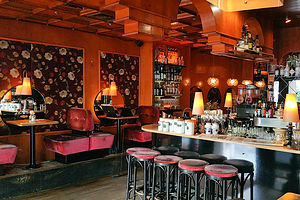 Hotel Lux BarGetting to Munich from our hotel involved a shuttle back to the airport and then a train, which dropped us off smack under the Marienplatz. Since our luggage was not exactly conducive to sight-seeing, after a quick glance around this beautiful square, we headed directly to our hotel, which fortunately was right near by. In fact, its proximity to the Marienplatz, which is the heart of Munich's Altstadt, is why we chose the Hotel Lux for our 3-day sojourn in the city.
Hotel Lux BarGetting to Munich from our hotel involved a shuttle back to the airport and then a train, which dropped us off smack under the Marienplatz. Since our luggage was not exactly conducive to sight-seeing, after a quick glance around this beautiful square, we headed directly to our hotel, which fortunately was right near by. In fact, its proximity to the Marienplatz, which is the heart of Munich's Altstadt, is why we chose the Hotel Lux for our 3-day sojourn in the city.
From the moment I stepped into the quaint old Hotel Bar, which also serves as the Reception area, I knew I would love this place. The hotel clerk was extremely friendly and helpful and spoke perfect English - in fact, he was actually from Portugal. It was much too early to check in, so he took our bags and suggested we wander over to the Viktualienmark to get a bite to eat. He would have our room ready for us by 2:00 pm.
We took his advice and walked the short distance to what was familiar to us as a farmers’ market in the states, but much larger and more permanent (open every day but Sunday). We didn’t know where to start - there were well over a hundred stalls and shops selling flowers, poultry, fish, exotic fruits, fresh produce, cheese, bread, wine, and all sorts of Bavarian specialties. There were wursts as far as the eye could see.
 MarienplatzIn the center of the Viktualienmarkt is a beer garden, which sits over 600 people, shaded by hundred-year old chestnut trees. Every six weeks or so they offer a different beer from one of the legendary breweries - Augustiner, Paulaner, Spaten, Hofbrau, Lowenbrau, etc. We weren’t quite ready for the beer portion of the day yet (still a bit jetlagged), so we just got panini sandwiches at one of the stalls and ate them on a bench, while watching the activity around us. The sandwiches were reasonably priced and delicious.
MarienplatzIn the center of the Viktualienmarkt is a beer garden, which sits over 600 people, shaded by hundred-year old chestnut trees. Every six weeks or so they offer a different beer from one of the legendary breweries - Augustiner, Paulaner, Spaten, Hofbrau, Lowenbrau, etc. We weren’t quite ready for the beer portion of the day yet (still a bit jetlagged), so we just got panini sandwiches at one of the stalls and ate them on a bench, while watching the activity around us. The sandwiches were reasonably priced and delicious.
Check-in time at our hotel was still awhile away, so we decided to do some sightseeing, beginning at the nearby Marienplatz, Munich’s vibrant city square since 1158. After only traveling in the U.S. up until now, and thinking that Independence Hall was old, it was mindblowing to contemplate just how much history there is here.
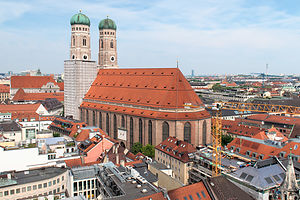 Frauenkirche from atop the Neues RathausThe Marienplatz is dominated by the Neues Rathaus (New Town Hall), which was built in the late 1800s. However, its neo-Gothic style makes it look much older than the Altes Rathaus on the other end of the square, which was built in the 1300s.
Frauenkirche from atop the Neues RathausThe Marienplatz is dominated by the Neues Rathaus (New Town Hall), which was built in the late 1800s. However, its neo-Gothic style makes it look much older than the Altes Rathaus on the other end of the square, which was built in the 1300s.
The most striking feature of the building is its 85-meter (255 foot) tower, which is home to the famous Glockenspiel. For 2 Euros, we took the lift to the top of the tower for a wonderful view of the city.
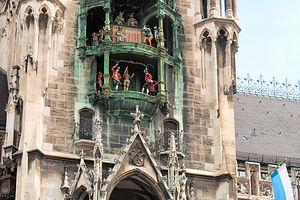 Glockenspiel in the MarienplatzAfterwards we made sure we were well positioned in the Marienplatz for the 11:00 am Glockenspiel show (there are only three shows a day in summer: 11:00 am, noon, and 5:00 pm). As the hour approached, we and about a hundred other tourists gazed anxiously upwards towards the balcony in the tower where the 32 figurines stood poised for action. Pretty close to the hour, the 43 bells started ringing and the upper balcony began spinning - sort of like a lazy Susan - while the figures also spun, acting out a 1568 knight’s tournament. When they were done, the lower balcony began to spin while barrel makers took their turn, performing a ritual dance to celebrate the end of the plague around 1500. I was glad that our timing worked out so that we could see it. After all, you can’t come to Munich and not experience the Glockenspiel.
Glockenspiel in the MarienplatzAfterwards we made sure we were well positioned in the Marienplatz for the 11:00 am Glockenspiel show (there are only three shows a day in summer: 11:00 am, noon, and 5:00 pm). As the hour approached, we and about a hundred other tourists gazed anxiously upwards towards the balcony in the tower where the 32 figurines stood poised for action. Pretty close to the hour, the 43 bells started ringing and the upper balcony began spinning - sort of like a lazy Susan - while the figures also spun, acting out a 1568 knight’s tournament. When they were done, the lower balcony began to spin while barrel makers took their turn, performing a ritual dance to celebrate the end of the plague around 1500. I was glad that our timing worked out so that we could see it. After all, you can’t come to Munich and not experience the Glockenspiel.
Munich is a very Catholic city and it served as the center of the German counter reformation. As a result, there are numerous cathedrals, each vying for the faithful’s attention with their spirituality and ornateness.
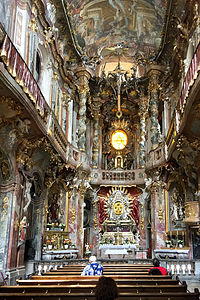 AsamkircheWe visited four that day, and I hate to admit it, but with the exception of one, they kind of blend together in my memory. I am going to start with the one that I didn’t forget, because it was the most amazing church I have ever seen.
AsamkircheWe visited four that day, and I hate to admit it, but with the exception of one, they kind of blend together in my memory. I am going to start with the one that I didn’t forget, because it was the most amazing church I have ever seen.
It’s called the Asamkirche and it is on Sendlinger Strasse about 600 meters southwest of the Marienplatz. We almost missed it, because from the outside it doesn’t even look like a church - but once we stepped inside, Wow! It was a baroque extravaganza, with every inch of its walls and ceilings covered with gold, Putti, frescoes, and stucco flourishes. It is the epitome of religious opulence and ostentatiousness. The church is tiny - only 30 feet wide and can fit only one pew across its nave.
It was built by two brothers in 1740 and meant to be their personal place of worship and eventually their burial place. However, higher-ups in the church hierarchy demanded that it be opened to the public, which thankfully for us, it still is today. Be sure to say hello to the gilded grim reaper on your left when leaving.
The other three cathedrals we visited that day were much more typical of what we expected, and each of them was beautiful and impressive in its own right. I will try to do them justice.
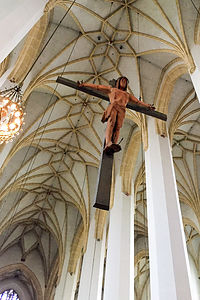 Frauenkirche - Van Dyck’s “Christ on the Cross”The Frauenkirche (Church of Our Lady), with its 99m high onion-domed towers, is the spiritual heart and symbol of Munich. This lovely Gothic church built in the 1400s is located just a few hundred yards northwest of the Marienplatz - in fact, we looked down on it from atop the observation deck of the Neues Rathaus. For a few Euros we could have ridden a lift to the top of the south tower and looked back at the Neues Rathaus, but we figured one aerial view of the city was sufficient.
Frauenkirche - Van Dyck’s “Christ on the Cross”The Frauenkirche (Church of Our Lady), with its 99m high onion-domed towers, is the spiritual heart and symbol of Munich. This lovely Gothic church built in the 1400s is located just a few hundred yards northwest of the Marienplatz - in fact, we looked down on it from atop the observation deck of the Neues Rathaus. For a few Euros we could have ridden a lift to the top of the south tower and looked back at the Neues Rathaus, but we figured one aerial view of the city was sufficient.
This church is huge and can seat 4,000 people - such a different feel than tiny little Asamkirche. However, like the Asamkirche, much of its interior was remodeled in the baroque style - but in a much more subtle manner. Van Dyck’s “Christ on the Cross” hangs impressively from the vaulted ceiling near the end of the nave.
One of the more interesting legends surrounding this church is that of the Devil Footprint. According to one version (and there are many), the Devil made a deal to finance the construction of the church if it was built without windows so that he could wander around in it as he pleased. However, the builders tricked the Devil with an architectural illusion by building windows that couldn’t be seen from the foyer. When the Devil realized he was duped, he stomped his foot, leaving a black mark on the floor that still remains today. I wish I had done my research before rather than after visiting this church, because I missed it. Hopefully, now my readers won’t.
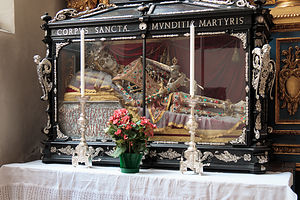 St. Peterskirche - Jeweled skeleton of a female martyrJust south of the Marienplatz is another one of Munich’s spiritual landmarks, St. Peterskirche, the oldest parish church in the city, known affectionately by locals as Alter Peter (“Old Peter”). Its interior is a virtual textbook of art through the centuries with an eclectic mix of Gothic, Baroque, and Rococo features. I thought the baroque ceiling fresco by Johann Baptist Zimmerman was absolutely stunning. However, I would have to say that my personal favorite was a jeweled skeleton of a female martyr in a glass coffin, located in a chapel on the left side of the church. It felt a bit like something you would find in a Ripley’s Believe It or Not. Kept hidden away in a wooden box since her beheading in 310 AD, Saint Munditia, the patron saint of spinsters, was put back on display in 1883. She was a beaut.
St. Peterskirche - Jeweled skeleton of a female martyrJust south of the Marienplatz is another one of Munich’s spiritual landmarks, St. Peterskirche, the oldest parish church in the city, known affectionately by locals as Alter Peter (“Old Peter”). Its interior is a virtual textbook of art through the centuries with an eclectic mix of Gothic, Baroque, and Rococo features. I thought the baroque ceiling fresco by Johann Baptist Zimmerman was absolutely stunning. However, I would have to say that my personal favorite was a jeweled skeleton of a female martyr in a glass coffin, located in a chapel on the left side of the church. It felt a bit like something you would find in a Ripley’s Believe It or Not. Kept hidden away in a wooden box since her beheading in 310 AD, Saint Munditia, the patron saint of spinsters, was put back on display in 1883. She was a beaut.
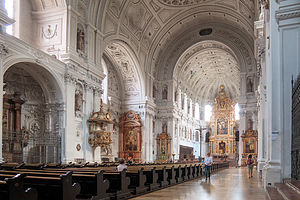 MichaelskircheAfter so many beautiful churches, it was hard to keep up the same level of awe. It was exhausting. Our last church of the day was Michaelskirche, just west of the Frauenkirche. At the time of its completion in 1597, it was the largest Renaissance church north of the Alps. With so many huge churches in such close proximity, I wonder just how full the pews could be on a Sunday morning - except in tiny Asamkirche. What stands out most for me in this church was its impressive unsupported barrel-vaulted ceiling. Also, it is the final resting place of “Mad” King Ludwig II, prolific builder of castles. For 2 Euro one can visit his humble tomb in the crypt - assuredly the only humble dwelling he ever spent time in.
MichaelskircheAfter so many beautiful churches, it was hard to keep up the same level of awe. It was exhausting. Our last church of the day was Michaelskirche, just west of the Frauenkirche. At the time of its completion in 1597, it was the largest Renaissance church north of the Alps. With so many huge churches in such close proximity, I wonder just how full the pews could be on a Sunday morning - except in tiny Asamkirche. What stands out most for me in this church was its impressive unsupported barrel-vaulted ceiling. Also, it is the final resting place of “Mad” King Ludwig II, prolific builder of castles. For 2 Euro one can visit his humble tomb in the crypt - assuredly the only humble dwelling he ever spent time in.
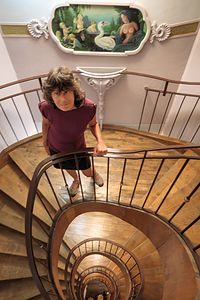 Hotel Lux - 4th FloorIt was nearing check-in time, so we walked backed to the Hotel Lux, and as promised, our room was ready and our bags had been brought upstairs. Thank God, because our room was on the fourth floor, which in Germany is really the fifth floor, because they call the street level one the ground floor and the second floor the first. Fortunately, we are still fit, but I can see how this could be a real problem for those that are less so. The wooden spiral staircase was beautiful though with artwork on the walls along the way to distract you. Our floor had a painting of a young bare-breasted mythological nymph at the top of the landing that over the next few days would inspire Herb to keep on climbing. We took a picture down from our floor to the bottom -- it looked like a wooden snail.
Hotel Lux - 4th FloorIt was nearing check-in time, so we walked backed to the Hotel Lux, and as promised, our room was ready and our bags had been brought upstairs. Thank God, because our room was on the fourth floor, which in Germany is really the fifth floor, because they call the street level one the ground floor and the second floor the first. Fortunately, we are still fit, but I can see how this could be a real problem for those that are less so. The wooden spiral staircase was beautiful though with artwork on the walls along the way to distract you. Our floor had a painting of a young bare-breasted mythological nymph at the top of the landing that over the next few days would inspire Herb to keep on climbing. We took a picture down from our floor to the bottom -- it looked like a wooden snail.
The room was small, but very neat and comfy. Like the Arcadia Hotel, the bed had two down duvets rather than a single comforter - to prevent “tucking and rolling” your partner’s blanket away. It really was a smart concept. We were pretty exhausted from our morning sightseeing and a bit of remaining jetlag, so we took a nap before heading out again.
We set off on foot to the English Gardens, Munich’s version of Central Park, about a mile and a half from our hotel. It was absolutely lovely, with miles and miles of paths winding along a lovely stream which flows the length of the park.
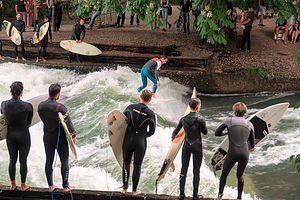 English Gardens SurfersShortly after entering the park, next to the Haus der Kunst, we came upon a crowd gathered on a bridge watching a group of surfers below -- that’s right, surfers in the middle of Munich. We had heard about this, but weren’t exactly sure where it was done, so I’m glad we stumbled upon it. The source of the wave was the Eisbach, an artificial stream that runs through the park. With a little help from some planks of wood hanging from the bridge arches, surfers have shaped and stabilized the flowing water in such a way as to create a continuous wave, about 1 meter high and 12 meters wide, flowing about about 5 meters per second. The better surfers were able to ride the wave back and forth across the stream for several minutes. It was really quite amazing to watch.
English Gardens SurfersShortly after entering the park, next to the Haus der Kunst, we came upon a crowd gathered on a bridge watching a group of surfers below -- that’s right, surfers in the middle of Munich. We had heard about this, but weren’t exactly sure where it was done, so I’m glad we stumbled upon it. The source of the wave was the Eisbach, an artificial stream that runs through the park. With a little help from some planks of wood hanging from the bridge arches, surfers have shaped and stabilized the flowing water in such a way as to create a continuous wave, about 1 meter high and 12 meters wide, flowing about about 5 meters per second. The better surfers were able to ride the wave back and forth across the stream for several minutes. It was really quite amazing to watch.
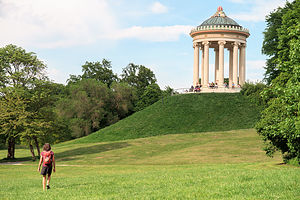 English Gardens MonopterosA little ways further in the park, we came upon an Ancient Greek style temple called the Monopteros. set atop a man-made hill. Monopteros is a Greek architectural term for a structure with a circular colonnade supporting a roof, but without any walls. It was quite lovely, and that hill just needed to be climbed. Apparently, the youth of Munich thought so too, as many of them were hanging out on its steps, socializing and having a few beers. From atop the hill, there were wonderful views of the city.
English Gardens MonopterosA little ways further in the park, we came upon an Ancient Greek style temple called the Monopteros. set atop a man-made hill. Monopteros is a Greek architectural term for a structure with a circular colonnade supporting a roof, but without any walls. It was quite lovely, and that hill just needed to be climbed. Apparently, the youth of Munich thought so too, as many of them were hanging out on its steps, socializing and having a few beers. From atop the hill, there were wonderful views of the city.
From there, we continued through the park to the Chinesischer Turm (Chinese Tower) where there is a huge beer garden with room to seat 7,000 people. We got in line and bought two one-liter mugs of beer, leaving a euro deposit for each of the mugs. When we first got there, it was relatively empty and we were able to easily find a seat at one of its green picnic tables. However, after about 5:30 or so (I assume the end of the German workday), people started arriving in droves on their bicycles, still dressed in the their work cloths, meeting up with friends and family. This was definitely not a tourist trap, but the real deal. What a wonderful custom to see families and friends talking and laughing together over a beer and a pretzel or some bratwurst.
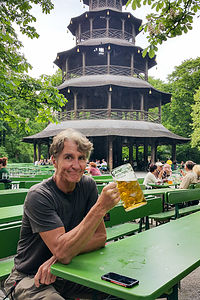 Herb enjoying the Chinesischer Turm beer gardenAfter finishing our beers - Herb had some of mine -- we walked the 2 ½ miles back to our hotel stopping along the way at the Isartor Gate, one of the four main gates of the old Medieval city wall (only three still remain). Completed in 1337, the gate has a 40-meter tower and was the main gate of Munich’s Salt Road. Murals of the Wittelsbachs’ past military victories adorn the walls over the arches. It is one of the most photographed landmarks in Munich.
Herb enjoying the Chinesischer Turm beer gardenAfter finishing our beers - Herb had some of mine -- we walked the 2 ½ miles back to our hotel stopping along the way at the Isartor Gate, one of the four main gates of the old Medieval city wall (only three still remain). Completed in 1337, the gate has a 40-meter tower and was the main gate of Munich’s Salt Road. Murals of the Wittelsbachs’ past military victories adorn the walls over the arches. It is one of the most photographed landmarks in Munich.
I’m not sure why, but we felt like we just had to have dinner at the Hofbrauhaus, the famous three-floor beer hall dating back to the 16th century located right near our hotel. It is a bit of a tourist trap - you won’t find many locals here - but still a lot of fun. However, it wasn’t long before we we were clapping along with the oom pah band, raising our mugs, and yelling “Zicke zacke, zicke zacke, hoi hoi hoi!”
It was hard to believe that we had only arrived in Munich that morning, as we had already covered so much ground and seen so much of the city. We were going to have to slow down the pace a bit if we were going to survive four weeks of this.
Day 2 - Munich's Art Museums (Alte Pinakothek, Neue Pinakothek, and Pinakothek der Moderne)
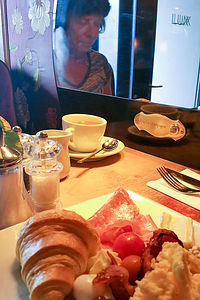 Hotel Lux breakfastOur stay at the Hotel Lux included a wonderful hot buffet breakfast with eggs, bacon, various other meats, fruit, fresh bread, etc. We helped ourselves to a heaping plate and sat in one of the booths in the very cozy bar. It was a great way to start our day.
Hotel Lux breakfastOur stay at the Hotel Lux included a wonderful hot buffet breakfast with eggs, bacon, various other meats, fruit, fresh bread, etc. We helped ourselves to a heaping plate and sat in one of the booths in the very cozy bar. It was a great way to start our day.
Munich has a wonderful art district called the Kunstereal, just west of the southern end of the English Gardens, and a little over a mile walk from our hotel. Since we couldn’t decide whether we were in the mood for Old Masters, baroque, impressionism, or modern, we figured we would try to do it all -- so much for slowing down the pace.
My sense of order required that we move sequentially from old to new, so we started our day at the Alte Pinakothek, which holds one of the most famous collections of Old Master paintings from the 14th through the 18th century. Since we planned to visit several museums that day, we purchased a combo ticket for 12 euros each.
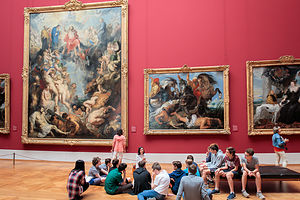 Alte Pinakothek - The Great Last Judgment by RubensThe Alte Pinakothek, which has a neo-classical exterior, was ordered to be built by King Ludwig I of Bavaria in 1826 to hold the Wittelsbach collection. At the time of its completion in 1836, it was the largest museum in the world and well ahead of its time in terms of skylights and room layout for displaying art. Up until then, art had pretty much been displayed on the interior walls of castles. The building became the model for new galleries throughout Europe. As with many old buildings, this one was in the midst of some construction work so parts of the museum were closed.
Alte Pinakothek - The Great Last Judgment by RubensThe Alte Pinakothek, which has a neo-classical exterior, was ordered to be built by King Ludwig I of Bavaria in 1826 to hold the Wittelsbach collection. At the time of its completion in 1836, it was the largest museum in the world and well ahead of its time in terms of skylights and room layout for displaying art. Up until then, art had pretty much been displayed on the interior walls of castles. The building became the model for new galleries throughout Europe. As with many old buildings, this one was in the midst of some construction work so parts of the museum were closed.
The list of artists whose works are on display is a veritable “Who’s Who of Renaissance, Baroque, and Rococo Art”: Albert Durer, Rogier van der Weyden, Hieronymus Bosch, Rembrandt, Frans Hal, Rubens, van Dyck, Pieter Bruegel the Elder (my personal favorite), Leonardo da Vinci, Giotto, Botticelli, Raphael, Titian, Tintoretto, El Greco, Velaquez, and on and on. No wonder this museum is featured in “1,000 Places to See Before you Die.”
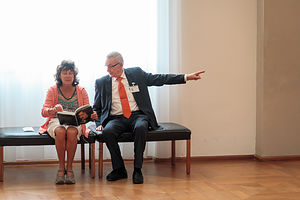 Lolo's new friend breaking it to her that there is no TitianWhile wandering through the gallery rooms, I don’t know what possessed me to ask a museum security guard where the Titian’s were. He did not speak a word of English, and no matter how many times I slowly said “Titian” in a German accent, he had no clue what I was looking for. He was so sweet though. He directed me to sit on a bench and quickly returned with a catalog of the museum’s collection. Herb looked a little confused when he found me and the elderly guard, sitting like old friends on a park bench, flipping through the pages of a catalog together. I never did find out if there were any Titians on display, but I did make a friend.
Lolo's new friend breaking it to her that there is no TitianWhile wandering through the gallery rooms, I don’t know what possessed me to ask a museum security guard where the Titian’s were. He did not speak a word of English, and no matter how many times I slowly said “Titian” in a German accent, he had no clue what I was looking for. He was so sweet though. He directed me to sit on a bench and quickly returned with a catalog of the museum’s collection. Herb looked a little confused when he found me and the elderly guard, sitting like old friends on a park bench, flipping through the pages of a catalog together. I never did find out if there were any Titians on display, but I did make a friend.
Moving along our timeline of art history, we continued on to the nearby Neue Pinakothek, which has an impressive collection of 19th and 20th century paintings and sculpture: Realism, Romanticism, Impressionism, Post-Impressionism, and Art Noveau. It too has an all-star lineup: Delacroix, Courbet, Millet, Manet, Monet, Renoir, Pisarro, Cezanne, Degas, Van Gogh, Munch, Klimt, Turner, and more.
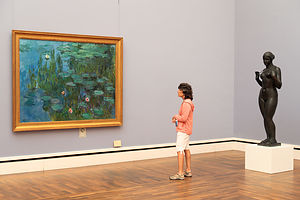 Lolo enjoying MonetImpressionism and Post Impressionism are my favorite types of art, so I felt quite at home wandering through the rooms, recognizing most of the artists before reading the plaques besides the paintings. It was like visiting old friends and family, and identifying distant cousins from their similar characteristics.
Lolo enjoying MonetImpressionism and Post Impressionism are my favorite types of art, so I felt quite at home wandering through the rooms, recognizing most of the artists before reading the plaques besides the paintings. It was like visiting old friends and family, and identifying distant cousins from their similar characteristics.
Although our combo pass was good for five museums, we concluded our museum tour with the Pinakothek der Moderne, one of the world’s largest museums for modern and contemporary art. It too was just a short walk away. The Museum is divided into four major collections.
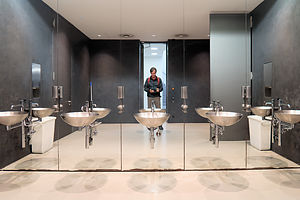 Pinakothek der Moderne - Mens RoomThe State Gallery of Modern Art contains works from artists such as Picasso, Braque, Matisse, Magritte, Klee, Dali, Kandinsky, Andy Warhol, and more. This is pretty much the collection we focused on. There is also the New Collection, which focuses on applied design, with such pieces as VW Beetles, Eames chairs, early Apple macs, etc. This was pretty interesting as well. We were pretty worn out by now and starting to glaze over, so we really did not give much attention to the Architectural collection, which focuses on the history of baroque and Bauhaus architecture, and the State Graphics Collection, which has drawings, prints, and engravings, from artists such as da Vinci, and Cezanne.
Pinakothek der Moderne - Mens RoomThe State Gallery of Modern Art contains works from artists such as Picasso, Braque, Matisse, Magritte, Klee, Dali, Kandinsky, Andy Warhol, and more. This is pretty much the collection we focused on. There is also the New Collection, which focuses on applied design, with such pieces as VW Beetles, Eames chairs, early Apple macs, etc. This was pretty interesting as well. We were pretty worn out by now and starting to glaze over, so we really did not give much attention to the Architectural collection, which focuses on the history of baroque and Bauhaus architecture, and the State Graphics Collection, which has drawings, prints, and engravings, from artists such as da Vinci, and Cezanne.
We really enjoyed the paintings, especially those by Magritte and Dali, but I am embarrassed to say that our favorite pieces of art (and ones that I only saw second hand) were the shiny silver sinks and creatively shaped urinals in the men’s room. Herb was kind enough to photograph them for my enjoyment.
Day 3 - Boulderwelt Climbing Gym, Orleansplatz Beer Garden, and English Gardens again
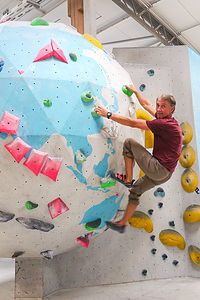 Herb at BoulderweltToday was an official public holiday in Germany. In fact, it was two - Ascension Day to mark Jesus’s ascension to heaven and Father’s Day, or Mannertag. I’m not sure how Ascension Day is celebrated but we certainly got a look at how Father’s Day is.
Herb at BoulderweltToday was an official public holiday in Germany. In fact, it was two - Ascension Day to mark Jesus’s ascension to heaven and Father’s Day, or Mannertag. I’m not sure how Ascension Day is celebrated but we certainly got a look at how Father’s Day is.
The first thing that surprised me is that in Bavaria men really do wear Lederhosen and those cute little hats with feathers in them, especially when out hiking or drinking beer, which is basically what Father’s Day is all about. Unlike in the States where fathers spend this day with their children, it is customary in Germany for groups of men, both young and old - excluding pre-teenage boys, I guess because of the beer drinking - to go on a hike together. In the old days, they used to pull a Bollerwagen behind them, full of wine, beer, and food. I’m not sure if this is still done today.
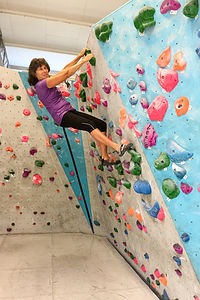 Lolo at BoulderweltI do know, however, that they do seem to pre-load for their hike, because by 10:00 am in the morning, the beer gardens were full of Lederhosen-clad men raising their mugs in celebration of their “fatherness.”
Lolo at BoulderweltI do know, however, that they do seem to pre-load for their hike, because by 10:00 am in the morning, the beer gardens were full of Lederhosen-clad men raising their mugs in celebration of their “fatherness.”
Poor Herb didn’t have his sons along to drink beer and hike with, so he was stuck with me, but I was after all the one that helped make him a father. I spent most of the rest of that day trying to convince him that he would look cute in Lederhosen, but he wasn’t buying it.
Since we had spent the last two days sightseeing, we decided to spend the day doing things that we would normally do at home, like going to a rock climbing gym. A quick internet search revealed that there was a bouldering gym about a mile and a half away on the eastern side of the Isar River. We have found on our travels, that visiting local climbing gyms is a great way to get some exercise, while spending time with locals rather than fellow tourists.
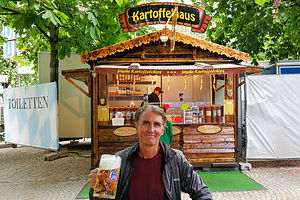 Herb enjoying German Father's Day in the OrleansplatzSo we headed off on foot to Boulderwelt, which turned out to be a very impressive bouldering gym. Normally, Herb and I like to top-rope, where you are tied in while climbing and your partner belays you to stop your falls. Bouldering is a little different in that there are no ropes involved. Rather, the climbs are short enough that falling onto the padded floors is not a problem. I still don’t particularly like falling through free space, even if it is only for a few feet. That tends to keep us on climbs graded easy enough where we feel pretty confident that we won’t fall. The younger people in the gym (which basically means all of them) had no problem dropping 6 to 10 feet onto the mats.
Herb enjoying German Father's Day in the OrleansplatzSo we headed off on foot to Boulderwelt, which turned out to be a very impressive bouldering gym. Normally, Herb and I like to top-rope, where you are tied in while climbing and your partner belays you to stop your falls. Bouldering is a little different in that there are no ropes involved. Rather, the climbs are short enough that falling onto the padded floors is not a problem. I still don’t particularly like falling through free space, even if it is only for a few feet. That tends to keep us on climbs graded easy enough where we feel pretty confident that we won’t fall. The younger people in the gym (which basically means all of them) had no problem dropping 6 to 10 feet onto the mats.
 Father's Day in the English GardensOn the walk back to the hotel, quite by accident, we stumbled upon a crowded beer garden in the Orleansplatz, complete with oom-pah band, food stalls, and of course, very large mugs of beer. It looked so festive that we just had to stop. We spent a very pleasant hour drinking beer, eating some kind of fried fish on a stick, and watching people, quite uninhibitedly, dancing in the square. It was so unexpected and so much fun. These people really knew how to celebrate Father’s Day.
Father's Day in the English GardensOn the walk back to the hotel, quite by accident, we stumbled upon a crowded beer garden in the Orleansplatz, complete with oom-pah band, food stalls, and of course, very large mugs of beer. It looked so festive that we just had to stop. We spent a very pleasant hour drinking beer, eating some kind of fried fish on a stick, and watching people, quite uninhibitedly, dancing in the square. It was so unexpected and so much fun. These people really knew how to celebrate Father’s Day.
Later that afternoon, we took another walk to the English Gardens, just to sit by the river and share in the festive mood of the people of Munich. It seemed like the whole city was out recreating. We really felt an affinity for the people of this wonderful city.
Description
While I will not attempt to do an in-depth description of all Munich has to offer -- there are numerous guidebooks to do just that -- the following is a list of interesting sites that we enjoyed:
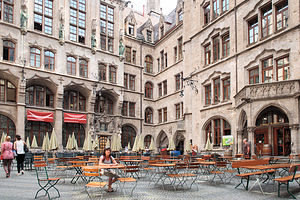 MarienplatzMarienplatz- city’s main square since 1158
MarienplatzMarienplatz- city’s main square since 1158
- Anchored by Mary’s Column built in 1838 to celebrate victory over Swedish forces during the Thirty Years’ War - topped by golden statue of the Virgin Mary balancing on a crescent moon
- Neues Rathaus - square is dominated by this neo-Gothic New Town Hall
- Take the lift up the 85m-tower for views of Munich ($1)
- Glockenspiel - 43 bells and 32 figures perform two actual historic events
- Top - story of a knight’s tournament in 1568
- Bottom - portrays the Schafflertanz - ritual dance by barrel makers to celebrate the end of the plague around 1500
- Altes Rathaus (eastern side of Marienplatz)
- Where Joseph Goebbels gave a hate-filled speech that launched Kristallnacht pogroms - today a toy museum
Viktualienmarkt (just south of St. Peterskirche)
- Munich’s famous farmers’ market (open every day but Sunday) with over a hundred stalls and shops selling flowers, poultry, fish, exotic fruits, fresh produce, cheese, bread, wine, and all sorts of Bavarian specialties.
- Blue and white striped Maypole
- Centerpiece – beer garden with picnic tables in shade of chestnut trees
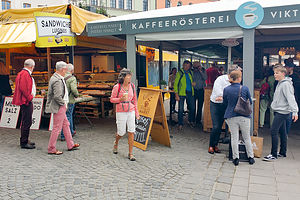 Vicktualienmarkt
Vicktualienmarkt
Frauenkirche (Church of Our Lady) - Frauenplatz 1 (just a few hundred yards NW of Marienplatz)
- Gothic style – build in 1400s
- Spiritual heart of Munich
- 99m high with onion-domed twin towers – symbol of the city
- Panoramic views from south tower (2 euro)
 St. PeterskircheSt. Peterskirche (Church of St. Peter)- Rindemarkt 1 (just south of Marienplatz)
St. PeterskircheSt. Peterskirche (Church of St. Peter)- Rindemarkt 1 (just south of Marienplatz)
- Munich’s oldest church (1136)
- 92-meter tower (300 steps) with best view of central Munich
- Virtual textbook of art through the centuries
- 2nd chapel on left – skeleton of female martyr in a box
- Nave lined with bronze statues of apostles
- Gothic St-Martin altar
- Johann Baptist Zimmermann’s baroque ceiling
- Ignaz Gunther’s rococo sculptures
Michaelskirche (Church of St. Michael) - Kaufingerstrasse 52 (just a little west of Frauenkirche)
- Completed in 1597 - then largest Renaissance church north of Alps
- Ornate baroque interior
- Impressive unsupported barrel-vaulted ceiling
- Most famous as final resting place of King Ludwig II - humble tomb in crypt (2 euro)
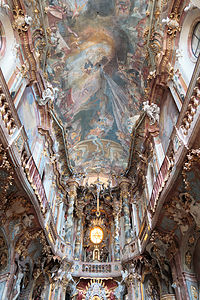 Asamkirche
Asamkirche
Asamkirche – 62 Sendlinger Strasse (just 600 yards SW of Marienplatz)
- Built in 1740 Pocket-sized (just 30 feet wide) late baroque created by two brothers
- Every inch of wall space covered with paintings, Putti, gold leaf, and stucco flourishes
- Dome – actually painting on a flat ceiling
- Marble columns – actually made of wood
- Gilded grim reaper – on left side as you are leaving
English Gardens (starts about 1 mile NE of Marienplatz)
- Bigger than Central Park
- Chinesischer Turm (Chinese Tower) - at the heart of Munich’s oldest beer garden
- Monopteros - small Greek temple with view of Munich skyline
 Isartor GateIsartor (Isar Gate) - about ¼ mile SE of Marienplatz
Isartor GateIsartor (Isar Gate) - about ¼ mile SE of Marienplatz
- One of the most photographed Munich landmarks,
- Only tower left from the wall that once encircled Munich
Hofbrauhaus - Am Platzl 9 (½ mile east of Marienplatz
- world’s most celebrated beer hall – 5000 seat
- very touristy but lots of fun
Marienhof (behind new Town Hall)
- Dallmayr Delicatessan – most aristocratic deli in all of Germany
Kunstereal (Art District)
- Alte Pinakothek - Barer Strasse 27 - (just 1 mile north of Marienplatz) - $7
- featured in 1,000 Places to See Before you Die
- Old World Masters between 14th and 18th centuries - Cranach the Elder, Durer, Rubens, Botticelli, Raphael, Titian, El Greco, Velazquez
- Neue Pinakothek - Barer Strasse 29 (near Alte Pinakothek) - $7
- 19th and 20th century paintings and sculpture from rococo to art nouveau - Monet, Cezanne, Degas, and Van Gogh
- Pinakothek der Moderne - Barer Strasse 40 (near Neue Pinakothek - $10
- Spectacular four-storey interior centered on an eye-like dome which spreads soft natural light throughout white galleries
- Four collections:
- State Gallery of Modern Art - Picasso, Klee, Dali, Kandinsky, Andy Warhol
- New Collection - focuses on applied design - VW Beetles, Eames chairs, early Apple macs
- State Graphics Collection - drawings, prints, engravings - da Vinci, Cezanne
- Architecture Museum - baroque architect and Bauhaus
- ‹ previous
- 2 of 17
- next ›
Munich location map in "high definition"
Javascript is required to view this map.
